Influence of Mixed Conifer Forest Thinning and Prescribed Fire on Soil Temperature and Moisture Dynamics in Proximity to Forest Logs: A Case Study in New Mexico, USA
Abstract
1. Introduction
2. Materials and Methods
3. Results
3.1. Forest Treatments
3.2. Site Climate Dynamics
3.3. Soil Temperatue Dynamics
3.4. Soil Moisture Dynamics
4. Discussion
5. Conclusions
Supplementary Materials
Author Contributions
Funding
Institutional Review Board Statement
Informed Consent Statement
Data Availability Statement
Acknowledgments
Conflicts of Interest
References
- Thom, D.; Seidl, R. Natural disturbance impacts on ecosystem services and biodiversity in temperate and boreal forests. Biol. Rev. 2016, 91, 760–781. [Google Scholar] [CrossRef] [PubMed]
- Kelly, L.T.; Giljohann, K.M.; Duane, A.; Aquilué, N.; Archibald, S.; Batllori, E.; Bennett, A.F.; Buckland, S.T.; Canelles, Q.; Clarke, M.F.; et al. Fire and biodiversity in the Anthropocene. Science 2020, 370, abb0355. [Google Scholar] [CrossRef] [PubMed]
- McDowell, N.G.; Allen, C.D.; Anderson-Teixeira, K.; Aukema, B.H.; Bond-Lamberty, B.; Chini, L.; Clark, J.S.; Dietze, M.; Grossiord, C.; Hanbury-Brown, A.; et al. Pervasive shifts in forest dynamics in a changing world. Science 2020, 368, eaaz9463. [Google Scholar] [CrossRef]
- McLauchlan, K.K.; Higuera, P.E.; Miesel, J.; Rogers, B.M.; Schweitzer, J.; Shuman, J.K.; Tepley, A.J.; Varner, J.M.; Veblen, T.T.; Adalsteinsson, S.A.; et al. Fire as a fundamental ecological process: Research advances and frontiers. J. Ecol. 2020, 108, 2047–2069. [Google Scholar] [CrossRef]
- Williams, A.P.; Cook, E.R.; Smerdon, J.E.; Cook, B.I.; Abatzoglou, J.T.; Bolles, K.; Baek, S.H.; Badger, A.M.; Livneh, B. Large contribution from anthropogenic warming to an emerging North American megadrought. Science 2020, 368, 314–318. [Google Scholar] [CrossRef] [PubMed]
- Jain, P.; Castellanos-Acuna, D.; Coogan, S.C.P.; Abatzoglou, J.T.; Flannigan, M.D. Observed increases in extreme fire weather driven by atmospheric humidity and temperature. Nat. Clim. Change 2022, 12, 63–70. [Google Scholar] [CrossRef]
- Abatzoglou, J.T.; Williams, A.P. Impact of anthropogenic climate change on wildfire across western US forests. Proc. Natl. Acad. Sci. USA 2016, 113, 11770–11775. [Google Scholar] [CrossRef] [PubMed]
- Kitzberger, T.; Falk, D.A.; Westerling, A.L.; Swetnam, T.W. Direct and indirect climate controls predict heterogeneous early-mid 21st century wildfire burned area across western and boreal North America. PLoS ONE 2017, 12, e0188486. [Google Scholar] [CrossRef]
- Stevens-Rumann, C.S.; Kemp, K.B.; Higuera, P.E.; Harvey, B.J.; Rother, M.T.; Donato, D.C.; Morgan, P.; Veblen, T.T. Evidence for declining forest resilience to wildfires under climate change. Ecol. Lett. 2018, 21, 243–252. [Google Scholar] [CrossRef]
- Coop, J.D.; Parks, S.A.; McClernan, S.R.; Holsinger, L.M. Influences of prior wildfires on vegetation response to subsequent fire in a reburned Southwestern landscape. Ecol. Appl. 2016, 26, 346–354. [Google Scholar] [CrossRef]
- Coop, J.D.; Parks, S.A.; Stevens-Rumann, C.S.; Crausbay, S.D.; Higuera, P.E.; Hurteau, M.D.; Tepley, A.; Whitman, E.; Assal, T.; Collins, B.M.; et al. Wildfire-driven forest conversion in western North American landscapes. BioScience 2020, 70, 659–673. [Google Scholar] [CrossRef]
- Guiterman, C.H.; Gregg, R.M.; Marshall, L.A.; Beckmann, J.J.; van Mantgem, P.J.; Falk, D.A.; Keeley, J.E.; Caprio, A.C.; Coop, J.D.; Fornwalt, P.J.; et al. Vegetation type conversion in the US Southwest: Frontline observations and management responses. Fire Ecol. 2022, 18, 6. [Google Scholar] [CrossRef]
- Castro, J.; Allen, C.D.; Molina-Morales, M.; Marañón-Jiménez, S.; Sánchez-Miranda, A.; Zamora, R. Salvage logging versus the use of burnt wood as a nurse object to promote post-fire tree seedling establishment. Restor. Ecol. 2011, 219, 537–544. [Google Scholar] [CrossRef]
- deMaynadier, P.G.; Hunter, M.L., Jr. The relationship between forest management and amphibian ecology: A review of the North American literature. Environ. Rev. 1995, 3, 230–261. [Google Scholar] [CrossRef]
- Graham, S.A. The felled tree trunk as an ecological unit. Ecology 1925, 6, 397–411. [Google Scholar] [CrossRef]
- Thorn, S.; Seibold, S.; Leverkus, A.B.; Michler, T.; Müller, J.; Noss, R.F.; Stork, N.; Vogel, S.; Lindenmayer, D.B. The living dead: Acknowledging life after tree death to stop forest degradation. Front. Ecol. Environ. 2020, 18, 505–512. [Google Scholar] [CrossRef]
- Rey, A.; Pegoraro, E.; Tedeschi, V.; de Parri, I.; Jarvis, P.G.; Valentini, R. Annual variation in soil respiration and its components in a coppice oak forest in Central Italy. Glob. Change Biol. 2002, 8, 851–866. [Google Scholar] [CrossRef]
- Peng, Y.; Thomas, S.C. Soil CO2 efflux in uneven-aged managed forests: Temporal patterns following harvest and effects of edaphic heterogeneity. Plant Soil 2006, 289, 253–264. [Google Scholar] [CrossRef]
- Guo, J.; Yang, Y.; Chen, G.; Xie, J.; Gao, R.; Qian, W. Effects of clear-cutting and slash burning on soil respiration in Chinese fir and evergreen broadleaved forests in mid-subtropical China. Plant Soil 2010, 333, 249–261. [Google Scholar] [CrossRef]
- Hagemann, U.; Martin, T.; Moroni, M.T.; Gleißner, J.; Makeschin, F. Disturbance history influences downed woody debris and soil respiration. For. Ecol. Manag. 2010, 260, 1762–1772. [Google Scholar] [CrossRef]
- Ruehr, N.K.; Knohl, A. Environmental variables controlling soil respiration on diurnal, seasonal and annual time-scales in a mixed mountain forest in Switzerland. Biogeochemistry 2010, 98, 153–170. [Google Scholar] [CrossRef]
- Marañón-Jiménez, S.; Castro, J.; Kowalski, A.S.; Serrano-Ortiz, P.; Reverter, B.R.; Sánchez-Cañete, E.P.; Zamora, R. Post-fire soil respiration in relation to burnt wood management in a Mediterranean mountain ecosystem. For. Ecol. Manag. 2011, 261, 1436–1447. [Google Scholar] [CrossRef]
- Xu, J.; Chen, J.; Brosofske, K.; Li, Q.; Weintraub, M.; Henderson, R.; Wilske, B.; John, R.; Jensen, R.; Li, H.; et al. Influence of timber harvesting alternatives on forest soil respiration and its biophysical regulatory factors over a 5-year period in the Missouri Ozarks. Ecosystems 2011, 14, 1310–1327. [Google Scholar] [CrossRef]
- Lepistö, A.; Futter, M.N.; Kortelainen, P. Almost 50 years of monitoring shows that climate, not forestry, controls long-term organic carbon fluxes in a large boreal watershed. Glob. Change Biol. 2014, 20, 1225–1237. [Google Scholar] [CrossRef] [PubMed]
- Kellman, L.; Myette, A.; Beltrami, H. Depth-dependent mineral soil CO2 production processes: Sensitivity to harvesting-induced changes in soil climate. PLoS ONE 2015, 10, e0134171. [Google Scholar] [CrossRef]
- Heilmann-Clausen, J.; Christensen, M. Fungal diversity on decaying beech logs—Implications for sustainable forestry. Biodivers. Conserv. 2003, 12, 953–973. [Google Scholar] [CrossRef]
- Ylisirniö, A.-L.; Mönkkönen, M.; Hallikainen, V.; Ranta-Maunus, T.; Kouki, J. Woodland key habitats in preserving polypore diversity in boreal forests: Effects of patch size, stand structure and microclimate. For. Ecol. Manag. 2016, 373, 138–148. [Google Scholar] [CrossRef]
- Wikars, L.-O.; Schimmel, J. Immediate effects of fire-severity on soil invertebrates in cut and uncut pine forests. For. Ecol. Manag. 2001, 141, 189–200. [Google Scholar] [CrossRef]
- Meehan, T.D. Mass and temperature dependence of metabolic rate in litter and soil invertebrates. Physiol. Biochem. Zool. 2006, 79, 878–884. [Google Scholar] [CrossRef]
- Bezkorovainaya, I.N.; Krasnoshchekova, E.N.; Ivanova, G.A. Transformation of soil invertebrate complex after surface fires of different intensity. Biol. Bull. 2007, 34, 517–522. [Google Scholar] [CrossRef]
- Koivula, M.; Vanha-Majamaa, I. Experimental evidence on biodiversity impacts of variable retention forestry, prescribed burning, and deadwood manipulation in Fennoscandia. Ecol. Process. 2020, 9, 11. [Google Scholar] [CrossRef]
- Cummer, M.R.; Painter, C.W. Three case studies of the effect of wildfire on the Jemez Mountains salamander (Plethodon neomexicanus): Microhabitat temperatures, size distributions, and a historical locality perspective. Southwest. Nat. 2007, 52, 26–37. [Google Scholar] [CrossRef]
- Haan, S.S.; Desmond, M.J.; Gould, W.R.; Ward, J.P., Jr. Influence of habitat characteristics on detected site occupancy of the New Mexico endemic Sacramento Mountains Salamander, Aneides Hardii. J. Herpetol. 2007, 41, 1–8. [Google Scholar] [CrossRef]
- Semlitsch, R.D.; Todd, B.D.; Blomquist, S.M.; Calhoun, A.J.K.; Gibbons, J.W.; Gibbs, J.P.; Graeter, G.J.; Harper, E.B.; Hocking, D.J.; Hunter, M.L., Jr.; et al. Effects of timber harvest on amphibian populations: Understanding mechanisms from forest experiments. BioScience 2009, 59, 853–862. [Google Scholar] [CrossRef]
- Kluber, M.R.; Olson, D.H.; Puettmann, K.J. Amphibian distributions in riparian and upslope areas and their habitat associations on managed forest landscapes in the Oregon Coast Range. For. Ecol. Manag. 2008, 256, 529–535. [Google Scholar] [CrossRef]
- Margenau, E.L.; Wood, P.B.; Brown, D.J.; Ryan, C.W. Evaluating mechanisms of short-term woodland salamander response to forest management. Environ. Manag. 2023, 71, 321–333. [Google Scholar] [CrossRef]
- Heithecker, T.D.; Halpern, C.B. Variation in microclimate associated with dispersed-retention harvests in coniferous forests of western Washington. For. Ecol. Manag. 2006, 226, 60–71. [Google Scholar] [CrossRef]
- Ma, S.; Concilio, A.; Oakley, B.; North, M.; Chen, J. Spatial variability in microclimate in a mixed conifer forest before and after thinning and burning treatments. For. Ecol. Manag. 2010, 259, 904–915. [Google Scholar] [CrossRef]
- Kovács, B.; Tinya, F.; Guba, E.; Németh, C.; Sass, V.; Bidló, A.; Ódor, P. The short-term effects of experimental forestry treatments on site conditions in an oak–hornbeam forest. Forests 2018, 9, 406. [Google Scholar] [CrossRef]
- Gray, A.N.; Zald, H.S.J.; Kern, R.A.; North, M. Stand conditions associated with tree regeneration in Sierran mixed conifer forests. For. Sci. 2005, 51, 198–210. [Google Scholar]
- Gordon, A.M.; Schlentner, R.E.; van Cleve, K. Seasonal patterns of soil respiration and CO2 evolution following harvesting in the white spruce of interior Alaska. Can. J. For. Res. 1987, 17, 304–310. [Google Scholar] [CrossRef]
- Bhatti, J.S.; Fleming, R.L.; Foster, N.W.; Meng, F.-R.; Bourque, C.P.A.; Arp, P.A. Simulations of pre- and post-harvest soil temperature, soil moisture, and snowpack for jack pine: Comparison with field observations. For. Ecol. Manag. 2000, 138, 413–426. [Google Scholar] [CrossRef]
- Slesak, R.A. Soil temperature following logging-debris manipulation and aspen regrowth in Minnesota: Implications for sampling depth and alteration of soil processes. Soil Sci. Soc. Am. J. 2013, 77, 1818–1824. [Google Scholar] [CrossRef]
- Webster, K.L.; Hazlett, P.W.; Brand, G.; Nelson, S.A.; Primavera, M.J.; Weldon, T.P. The effect of boreal jack pine harvest residue retention on soil environment and processes. For. Ecol. Manag. 2021, 497, 119517. [Google Scholar] [CrossRef]
- Yamulki, S.; Forster, J.; Xenakis, G.; Ash, A.; Brunt, J.; Perks, M.; Morison, J.I.L. Effects of clear-fell harvesting on soil CO2, CH4, and N2O fluxes in an upland Sitka spruce stand in England. Biogeosciences 2021, 18, 4227–4241. [Google Scholar] [CrossRef]
- Harrington, T.B.; Slesak, R.A.; Schoenholtz, S.H. Variation in logging debris cover influences competitor abundance, resource availability, and early growth of planted Douglas-fir. For. Ecol. Manag. 2013, 296, 41–52. [Google Scholar] [CrossRef]
- Harrington, T.B.; Peter, D.H.; Slesak, R.A. Logging debris and herbicide treatments improve growing conditions for planted Douglas-fir on a droughty forest site invaded by Scotch broom. For. Ecol. Manag. 2018, 417, 31–39. [Google Scholar] [CrossRef]
- Trottier-Picard, A.; Thiffault, E.; DesRochers, A.; Paré, D.; Thiffault, N.; Messier, C. Amounts of logging residues affect planting microsites: A manipulative study across northern forest ecosystems. For. Ecol. Manag. 2014, 312, 203–215. [Google Scholar] [CrossRef]
- Cirelli, D.; Vinge, T.; Lieffers, V.J. Assisted lodgepole pine regeneration on reclamation sites using logging slash as both a mulch and natural seed source. Can. J. For. Res. 2016, 46, 1132–1137. [Google Scholar] [CrossRef]
- Weber, M.G. Forest soil respiration after cutting and burning in immature aspen ecosystems. For. Ecol. Manag. 1990, 31, 1–14. [Google Scholar] [CrossRef]
- Kulmalaa, L.; Aaltonen, H.; Berninger, F.; Kieloaho, A.-J.; Levula, J.; Bäck, J.; Hari, P.; Kolari, P.; Korhonen, J.F.J.; Kulmala, M.; et al. Changes in biogeochemistry and carbon fluxes in a boreal forest after the clear-cutting and partial burning of slash. Agric. For. Meteorol. 2014, 188, 33–44. [Google Scholar] [CrossRef]
- Peterson, C.J.; Leach, A.D. Salvage logging after windthrow alters microsite diversity, abundance and environment, but not vegetation. Forestry 2008, 81, 361–376. [Google Scholar] [CrossRef]
- Marcolin, E.; Marzano, R.; Vitali, A.; Garbarino, M.; Lingua, E. Post-fire management impact on natural forest regeneration through altered microsite conditions. Forests 2019, 10, 1014. [Google Scholar] [CrossRef]
- Urretavizcaya, M.F.; Defossé, G.E. Restoration of burned and post-fire logged Austrocedrus chilensis stands in Patagonia: Effects of competition and environmental conditions on seedling survival and growth. Int. J. Wildland Fire 2019, 28, 365–376. [Google Scholar] [CrossRef]
- Wooten, J.T.; Stevens-Rumann, C.S.; Schapira, Z.H.; Rocca, M.E. Microenvironment characteristics and early regeneration after the 2018 Spring Creek Wildfire and post-fire logging in Colorado, USA. Fire Ecol. 2022, 18, 10. [Google Scholar] [CrossRef]
- Goff, F. Valles Caldera: A Geologic History; University of New Mexico Press: Albuquerque, NM, USA, 2009. [Google Scholar]
- Balmat, J.; Kupfer, J. Assessment of Timber Resources and Logging History of the Valles Caldera National Preserve; Technical Report VCT04011 for Valles Caldera Trust; University of Arizona: Tucson, AZ, USA, 2004; p. 69. [Google Scholar]
- Hibner, C.D.; Strenger, S.; Miller, A.; Sebring, S.; Olson, D.; Nemecek, J.; Schmit, S.; Bishop, C.; Ferguson, C.; Robbie, W.; et al. Terrestrial Ecological Unit Inventory of the Valles Caldera National Preserve, Sandoval County, New Mexico; Unpublished Report; USDA Forest Service, Region 3, Albuquerque, New Mexico and Natural Resources Conservation Service; USDA: Santa Fe, NM, USA, 2010. [Google Scholar]
- Western Regional Climate Center (WRCC). Valles Caldera National Preserve Climate Stations. 2022. Available online: https://wrcc.dri.edu/vallescaldera/ (accessed on 15 October 2022).
- Suazo, M.M.; Oertel, R.; Trader, L. Valles Caldera National Preserve: Forest monitoring objectives and methods. In Methods Manual; National Park Service: Valles Caldera National Preserve: Jemez Springs, NM, USA, 2013. Available online: https://irma.nps.gov/DataStore/Reference/Profile/2298941 (accessed on 15 January 2023).
- Litvak, M. AmeriFlux BASE US-Vcs Valles Caldera Sulphur Springs Mixed Conifer. version 12-5; AmeriFlux AMP, (Dataset); Lawrence Berkeley National Laboratory: Berkeley, CA, USA, 2022. [Google Scholar] [CrossRef]
- Keane, R.E.; Ryan, K.C.; Veblen, T.T.; Allen, C.D.; Logan, J.; Hawkes, B. Cascading Effects of Fire Exclusion in the Rocky Mountain Ecosystems: A Literature Review; General Technical Report, RMRSGTR-91; U.S. Department of Agriculture, Forest Service, Rocky Mountain Research Station: Denver, CO, USA, 2002; p. 24. [Google Scholar]
- Buford, M.; Chan, C.; Crockett, J.; Reinhardt, E.; Sloan, J. From Accelerating Restoration to Creating and Maintaining Resilient Landscapes and Communities across the Nation; USDA Forest Service Report FS-1069; USDA Forest Service: Washington, DC, USA, 2015. Available online: https://www.fs.usda.gov/sites/default/files/accelerating-restoration-update-2015-508-compliant.pdf (accessed on 15 January 2023).
- Veatch, W.; Brooks, P.D.; Gustafson, J.R.; Molotch, N.P. Quantifying the effects of forest canopy cover on net snow accumulation at a continental, mid-latitude site. Ecohydrology 2009, 2, 115–128. Available online: https://soi.org/10.1002/eco.45 (accessed on 15 January 2023). [CrossRef]
- Hölldobler, B.; Wilson, E.O. The Ants; Belknap Press: Cambridge, MA, USA, 1990. [Google Scholar]
- Chapman, R.F.; Joern, A. Biology of Grasshoppers; John Wiley & Sons: New York, NY, USA, 1990. [Google Scholar]
- Hossack, B.R.; Eby, L.A.; Guscio, C.G.; Corn, P.S. Thermal characteristics of amphibian microhabitats in a fire-disturbed landscape. For. Ecol. Manag. 2009, 258, 1414–1421. [Google Scholar] [CrossRef]
- Kluber, M.R.; Olson, D.H.; Puettmann, K.J. Downed wood microclimates and their potential impact on plethodontid salamander habitat in the Oregon Coast Range. Northwest Sci. 2009, 83, 25–34. [Google Scholar] [CrossRef]
- Green, M.B.; Fraver, S.; Lutz, D.A.; Woodall, C.W.; D’Amato, A.W.; Evans, D.M. Does deadwood moisture vary jointly with surface soil water content? Soil Sci. Soc. Am. J. 2022, 86, 1113–1121. [Google Scholar] [CrossRef]
- Reagan, D.P. Ecology and distribution of the Jemez Mountains salamander, Plethodon neomexicanus. Copeia 1972, 1972, 486–492. [Google Scholar] [CrossRef]
- Whitford, W.G. Physiological responses to temperature and desiccation in the endemic New Mexico plethodontids, Plethodon neomexicanus and Aneides Hardii. Copeia 1968, 1968, 247–251. Available online: http://www.jstor.org/stable/1441750?origin=JSTOR-pdf (accessed on 15 January 2023). [CrossRef]
- Everette, E.M. Habitat Characterization and Environmental Influences of the Jemez Mountains Salamander (Plethodon neomexicanus). Master’s Thesis, New Mexico State University, Las Cruces, NM, USA, 2003. [Google Scholar]
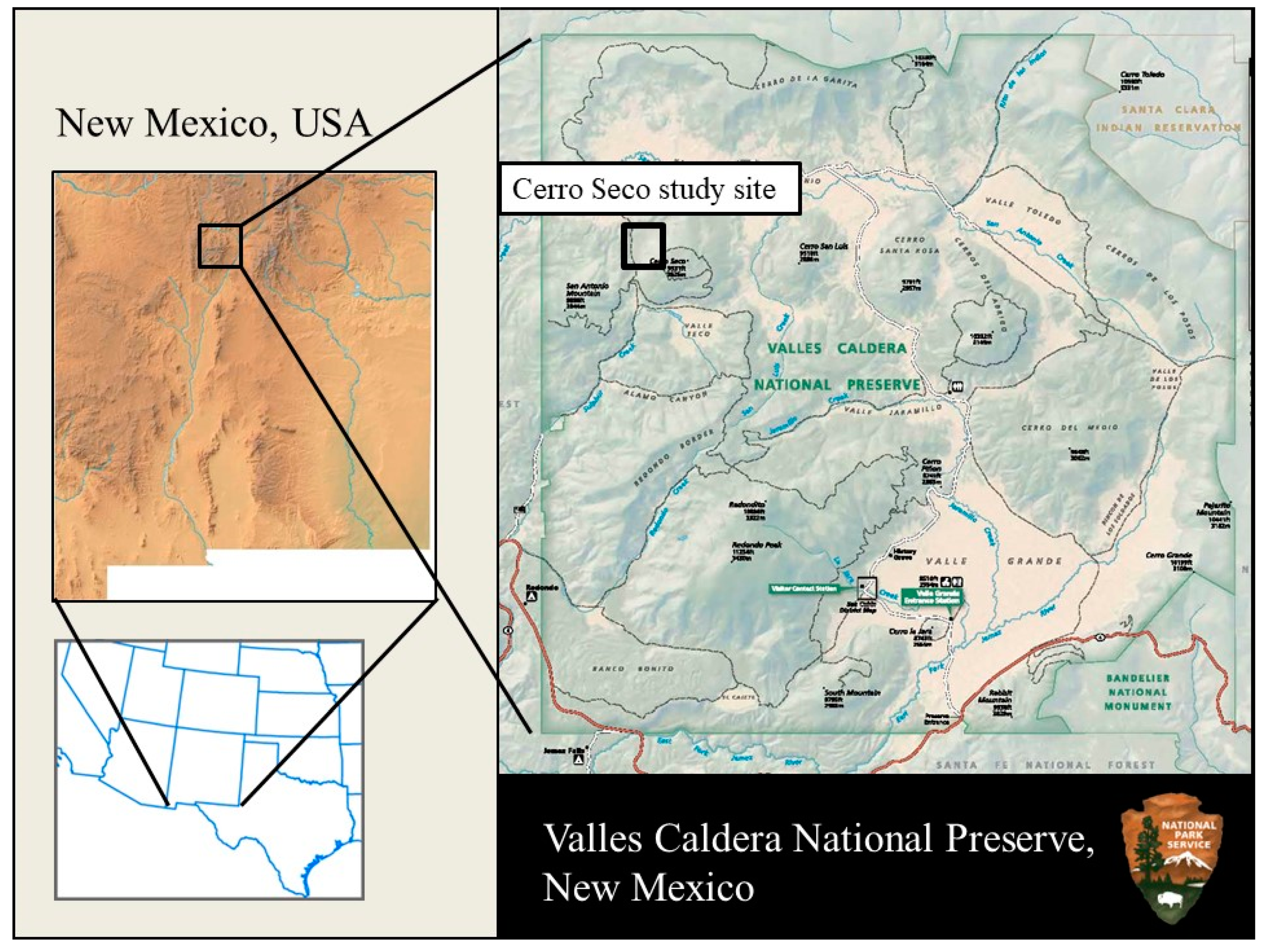
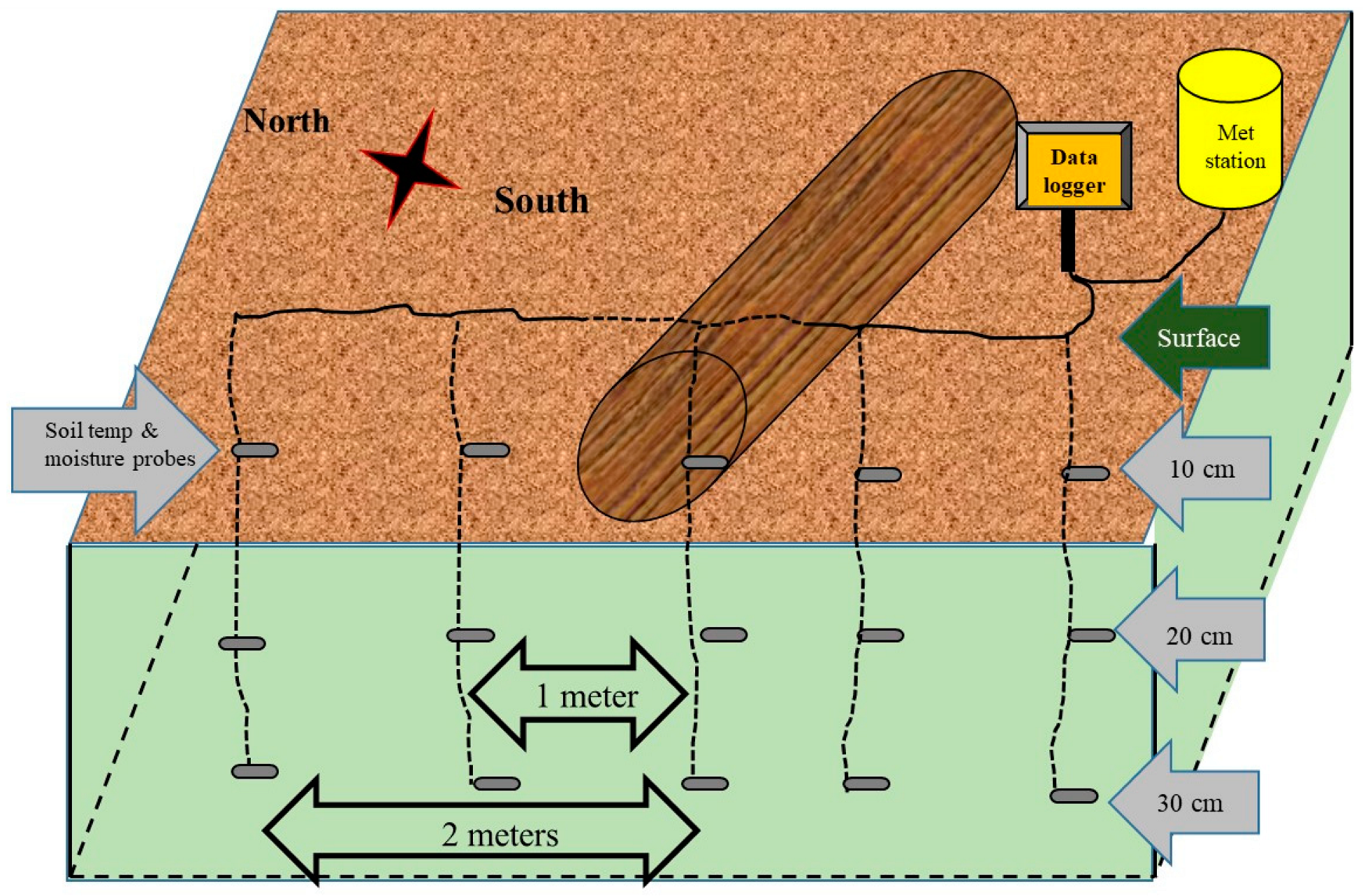
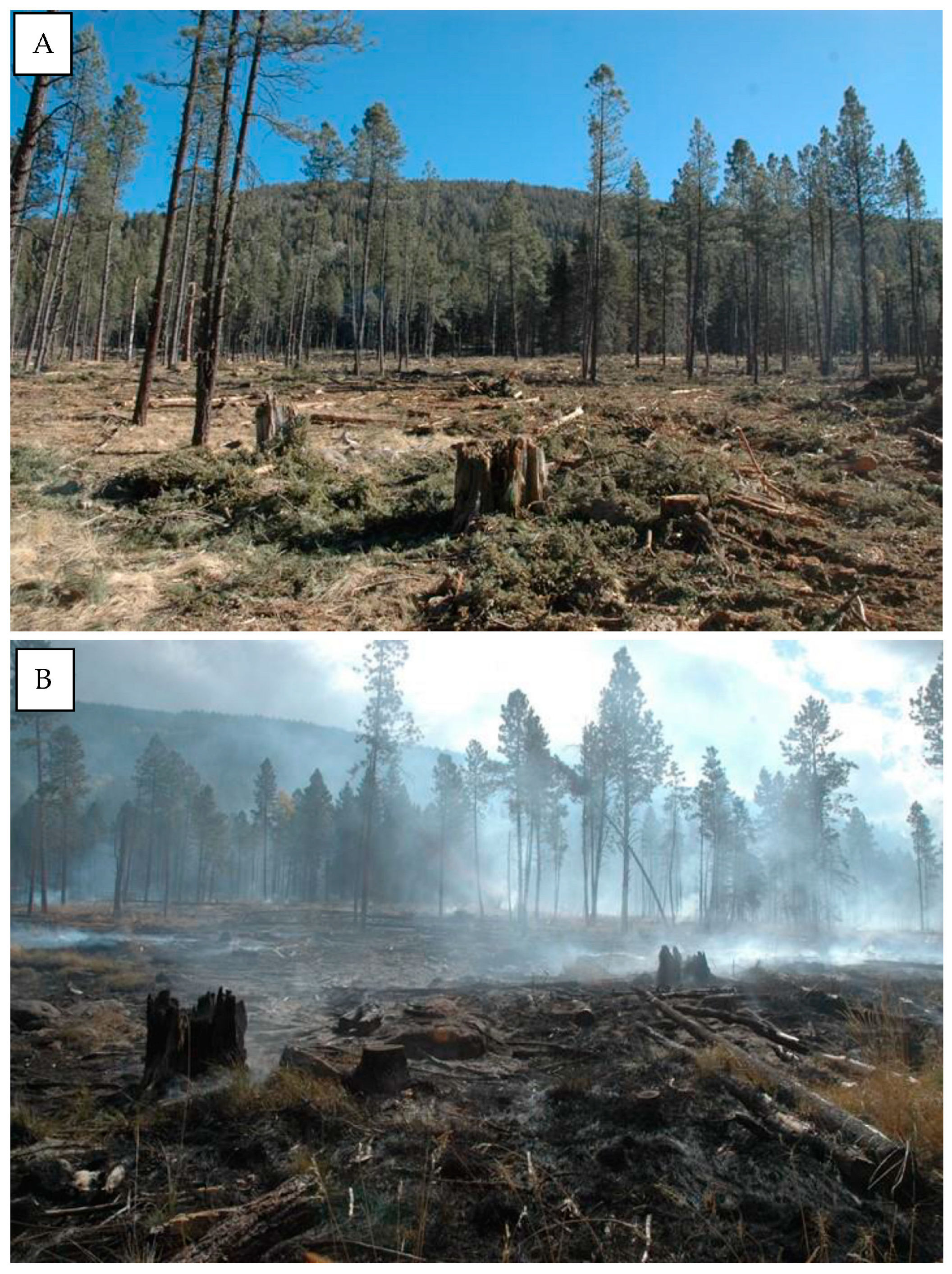

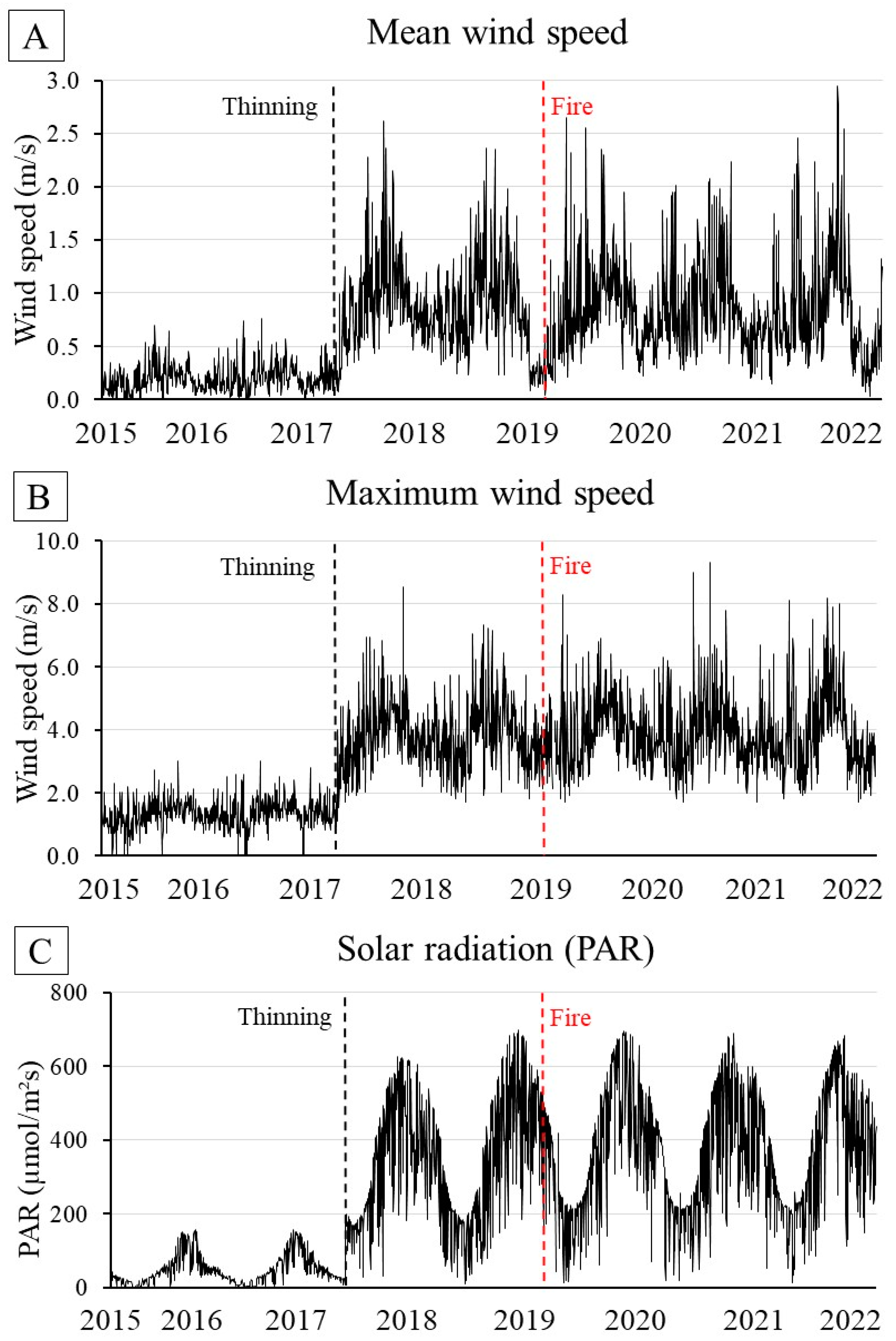
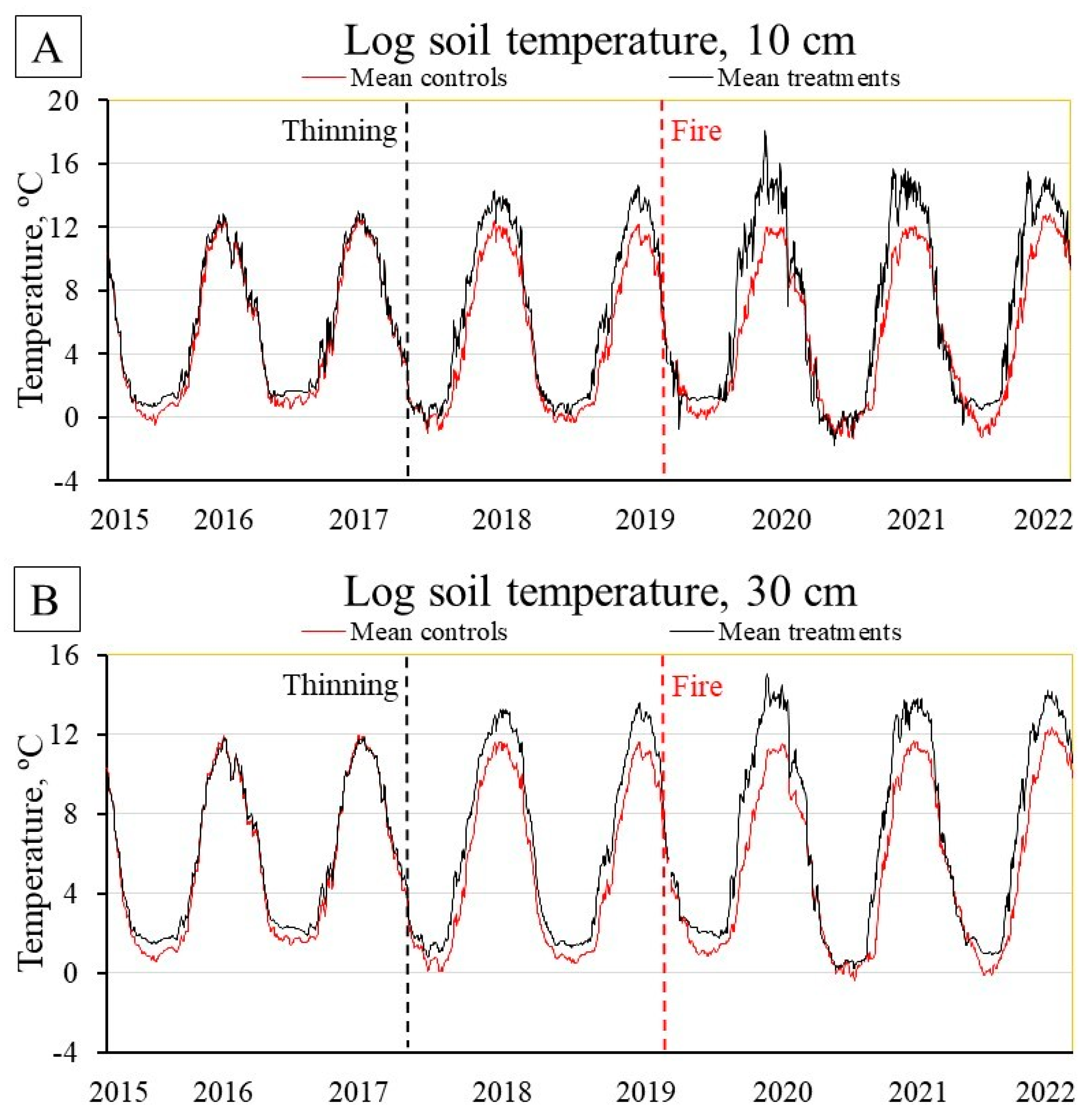
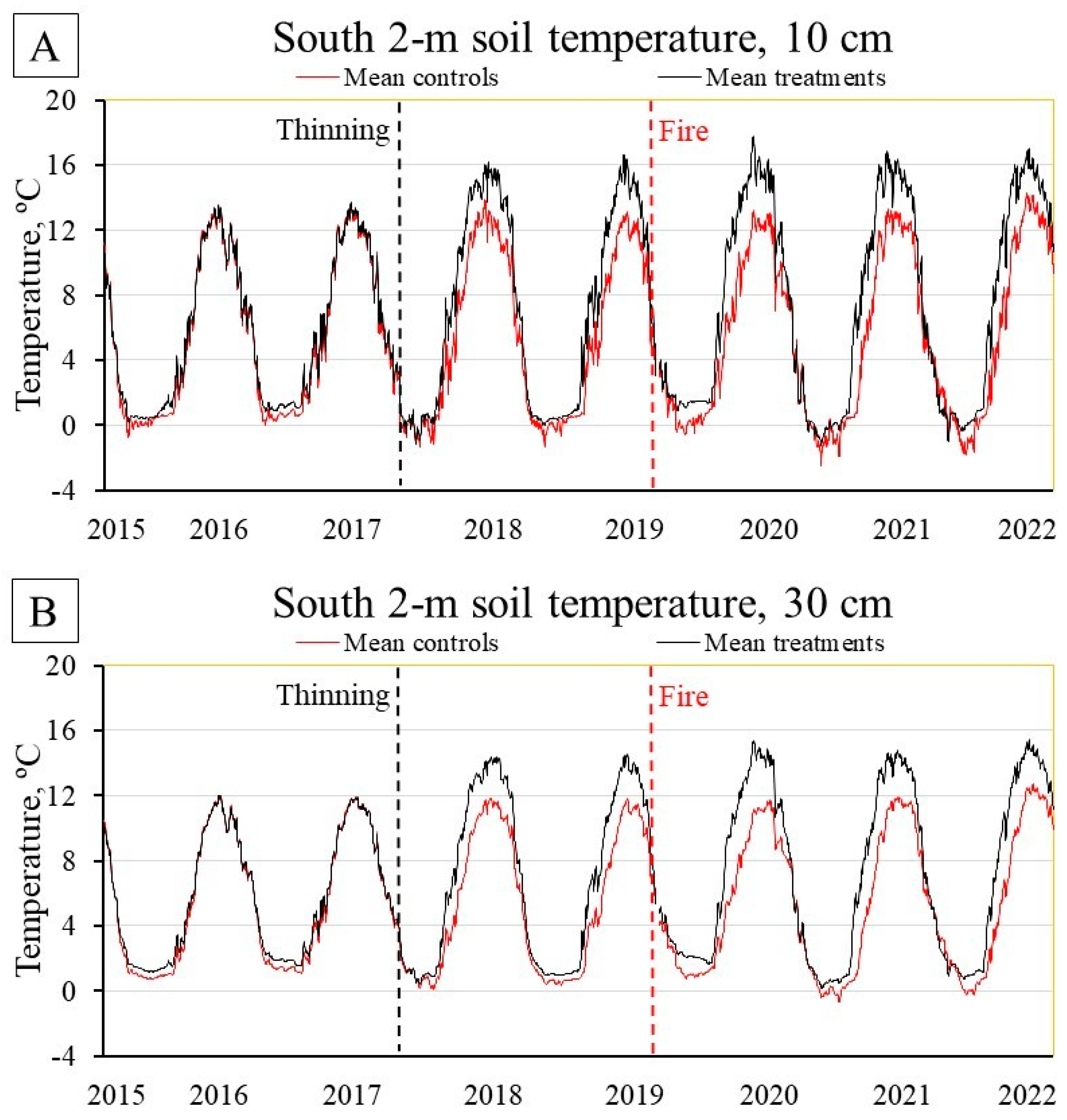

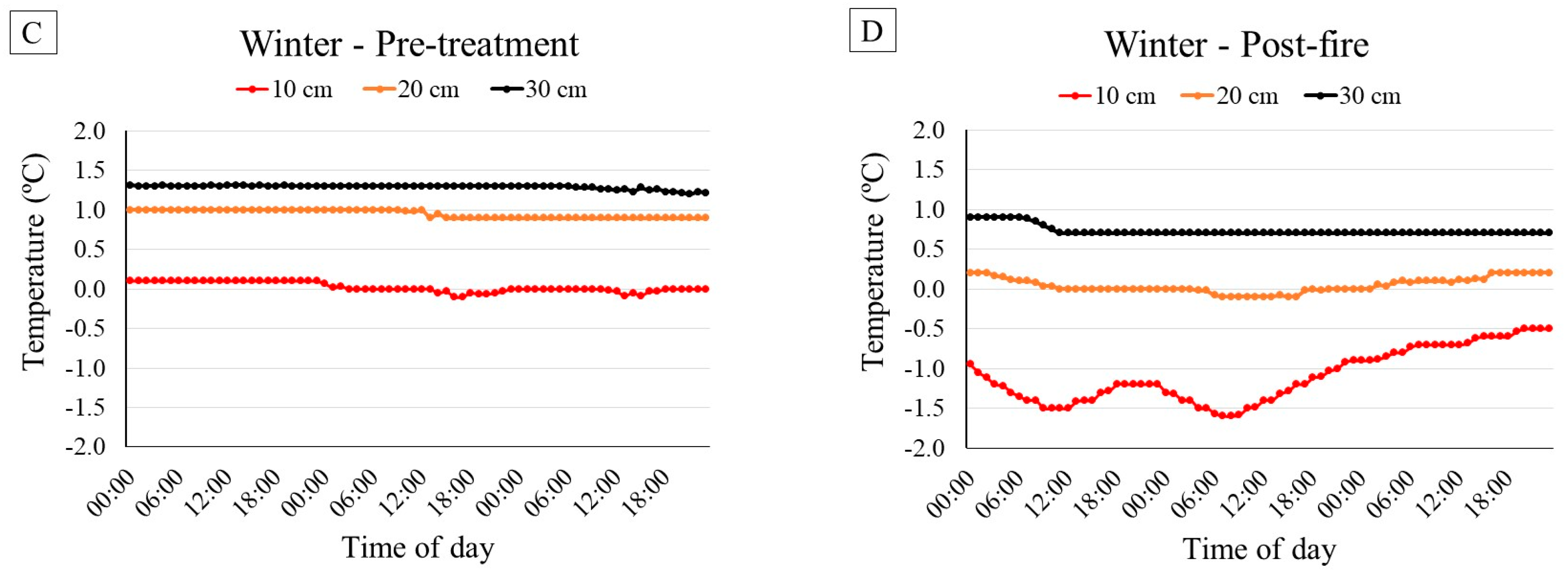

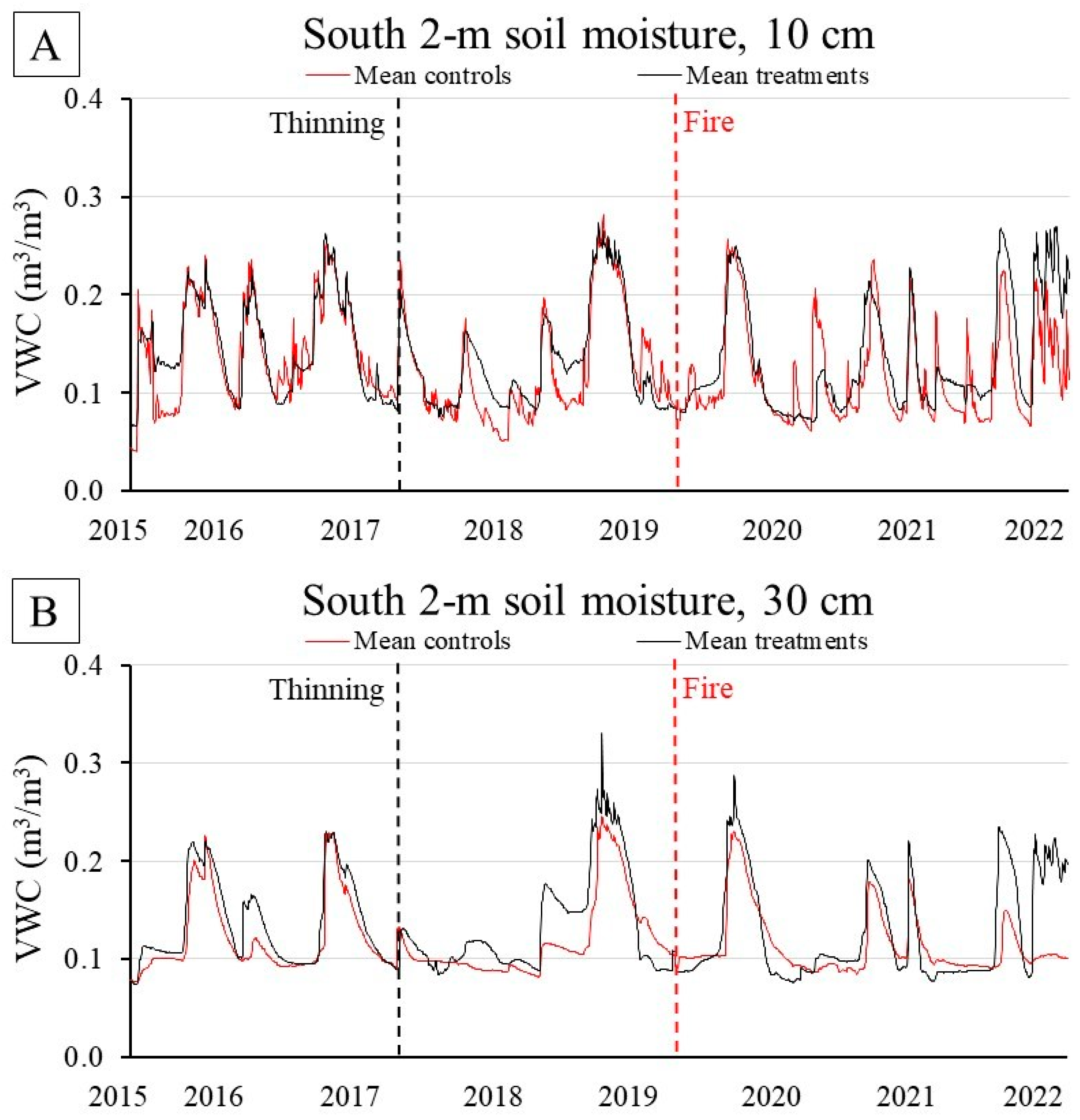
| Site | Period | Air Temperature (°C) | Relative Humidity (%) | PAR (µmol/m2s) | Mean Wind Speed (m/s) | Maximum Wind Speed (m/s) |
|---|---|---|---|---|---|---|
| Control | Pre-treatment | 5.14 ± 0.99 A | 0.69 ± 0.02 A | 52 ± 5 A | 0.17 ± 0.01 A | 1.27 ± 0.03 A |
| Post-thinning | 5.28 ± 1.02 A | 0.61 ± 0.02 B | 63 ± 5 AB | 0.27 ± 0.01 B | 1.87 ± 0.05 B | |
| Post-fire | 5.28 ± 1.04 A | 0.61 ± 0.02 B | 65 ± 5 B | 0.25 ± 0.01 B | 1.92 ± 0.04 B | |
| Treatment | Pre-treatment | 5.58 ± 0.98 A | 0.67 ± 0.02 A | 53 ± 5 A | 0.24 ± 0.01 A | 1.49 ± 0.03 C |
| Post-thinning | 6.24 ± 1.00 B | 0.57 ± 0.01 B | 258 ± 14 C | 0.75 ± 0.03 B | 3.53 ± 0.08 D | |
| Post-fire | 6.34 ± 1.01 B | 0.57 ± 0.02 B | 287 ± 14 D | 0.84 ± 0.04 C | 3.79 ± 0.09 E |
| Post-Thinning, Pre-Fire | Post-Fire | ||||||||
|---|---|---|---|---|---|---|---|---|---|
| (Water Years 2018, 2019) | (Water Years 2020, 2021, 2022) | ||||||||
| Microsite | Variable | Fall | Winter | Spring | Summer | Fall | Winter | Spring | Summer |
| Log | T10 | 1.15 | 0.02 | 1.20 | 1.69 | 0.42 | −0.46 | 2.17 | 2.54 |
| T20 | 1.30 | 0.01 | 1.14 | 1.72 | 0.62 | −0.47 | 2.03 | 2.68 | |
| T30 | 1.43 | 0.18 | 1.16 | 1.77 | 1.19 | −0.15 | 1.98 | 2.75 | |
| 1-m north | T10 | 1.37 | −0.51 | 2.14 | 2.06 | 1.20 | −0.27 | 2.06 | 2.18 |
| T20 | 1.45 | −0.41 | 1.68 | 1.95 | 1.25 | 0.02 | 1.48 | 2.24 | |
| T30 | 1.49 | −0.43 | 1.62 | 1.87 | 1.40 | −0.17 | 1.33 | 2.25 | |
| 2-m north | T10 | 1.65 | 0.01 | 2.35 | 2.40 | 1.31 | 0.44 | 2.75 | 2.28 |
| T20 | 1.64 | 0.03 | 2.17 | 2.25 | 1.37 | 0.39 | 2.47 | 2.30 | |
| T30 | 1.64 | 0.05 | 1.85 | 2.04 | 1.50 | 0.40 | 2.09 | 2.30 | |
| 1-m south | T10 | 1.93 | −0.04 | 1.97 | 2.41 | 1.36 | 0.18 | 2.95 | 2.70 |
| T20 | 2.01 | 0.01 | 1.82 | 2.36 | 1.65 | 0.21 | 2.82 | 2.86 | |
| T30 | 1.91 | 0.01 | 1.69 | 2.28 | 1.69 | 0.24 | 2.67 | 2.91 | |
| 2-m south | T10 | 1.86 | −0.01 | 2.30 | 2.84 | 1.55 | 0.14 | 3.63 | 3.38 |
| T20 | 1.83 | −0.02 | 2.13 | 2.84 | 1.51 | 0.14 | 3.29 | 3.31 | |
| T30 | 1.85 | −0.02 | 1.93 | 2.77 | 1.71 | 0.19 | 3.00 | 3.37 | |
| Post-Thinning, Pre-Fire | Post-Fire | ||||||||
|---|---|---|---|---|---|---|---|---|---|
| (Water Years 2018, 2019) | (Water Years 2020, 2021, 2022) | ||||||||
| Microsite | Variable | Fall | Winter | Spring | Summer | Fall | Winter | Spring | Summer |
| Log | VWC10 | 0.00 | −0.03 | 0.00 | −0.02 | 0.01 | 0.00 | 0.00 | −0.01 |
| VWC20 | 0.03 | −0.01 | 0.03 | 0.01 | 0.05 | 0.05 | 0.07 | 0.05 | |
| VWC30 | 0.03 | 0.01 | 0.03 | 0.02 | 0.07 | 0.08 | 0.08 | 0.08 | |
| 1-m north | VWC10 | −0.03 | 0.00 | −0.06 | −0.05 | −0.03 | −0.03 | −0.07 | −0.04 |
| VWC20 | −0.02 | 0.04 | 0.01 | −0.01 | 0.00 | 0.01 | 0.04 | −0.01 | |
| VWC30 | −0.01 | 0.03 | 0.03 | 0.00 | 0.00 | 0.04 | 0.04 | 0.00 | |
| 2-m north | VWC10 | 0.01 | 0.01 | 0.01 | −0.01 | 0.02 | 0.05 | 0.01 | 0.00 |
| VWC20 | 0.02 | 0.00 | 0.03 | 0.00 | 0.04 | 0.04 | 0.02 | 0.01 | |
| VWC30 | 0.00 | 0.00 | 0.02 | −0.01 | 0.02 | 0.03 | 0.01 | −0.01 | |
| 1-m south | VWC10 | 0.03 | 0.05 | 0.06 | 0.04 | 0.04 | 0.06 | 0.07 | 0.04 |
| VWC20 | 0.04 | 0.05 | 0.08 | 0.05 | 0.05 | 0.06 | 0.08 | 0.05 | |
| VWC30 | 0.04 | 0.02 | 0.05 | 0.03 | 0.06 | 0.06 | 0.07 | 0.05 | |
| 2-m south | VWC10 | −0.01 | 0.00 | 0.02 | 0.01 | 0.00 | 0.00 | 0.01 | 0.01 |
| VWC20 | 0.00 | 0.02 | 0.02 | −0.01 | −0.02 | 0.00 | 0.00 | −0.02 | |
| VWC30 | −0.02 | 0.02 | 0.01 | −0.02 | −0.03 | 0.00 | 0.01 | −0.03 | |
Disclaimer/Publisher’s Note: The statements, opinions and data contained in all publications are solely those of the individual author(s) and contributor(s) and not of MDPI and/or the editor(s). MDPI and/or the editor(s) disclaim responsibility for any injury to people or property resulting from any ideas, methods, instructions or products referred to in the content. |
© 2023 by the authors. Licensee MDPI, Basel, Switzerland. This article is an open access article distributed under the terms and conditions of the Creative Commons Attribution (CC BY) license (https://creativecommons.org/licenses/by/4.0/).
Share and Cite
Parmenter, R.R.; Losleben, M.V. Influence of Mixed Conifer Forest Thinning and Prescribed Fire on Soil Temperature and Moisture Dynamics in Proximity to Forest Logs: A Case Study in New Mexico, USA. Forests 2023, 14, 1117. https://doi.org/10.3390/f14061117
Parmenter RR, Losleben MV. Influence of Mixed Conifer Forest Thinning and Prescribed Fire on Soil Temperature and Moisture Dynamics in Proximity to Forest Logs: A Case Study in New Mexico, USA. Forests. 2023; 14(6):1117. https://doi.org/10.3390/f14061117
Chicago/Turabian StyleParmenter, Robert R., and Mark V. Losleben. 2023. "Influence of Mixed Conifer Forest Thinning and Prescribed Fire on Soil Temperature and Moisture Dynamics in Proximity to Forest Logs: A Case Study in New Mexico, USA" Forests 14, no. 6: 1117. https://doi.org/10.3390/f14061117
APA StyleParmenter, R. R., & Losleben, M. V. (2023). Influence of Mixed Conifer Forest Thinning and Prescribed Fire on Soil Temperature and Moisture Dynamics in Proximity to Forest Logs: A Case Study in New Mexico, USA. Forests, 14(6), 1117. https://doi.org/10.3390/f14061117






